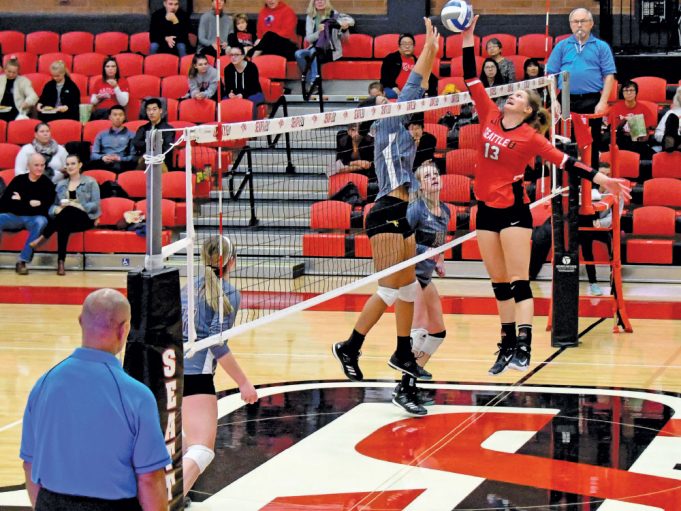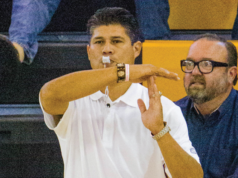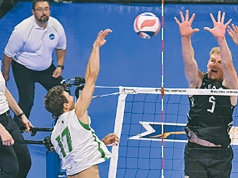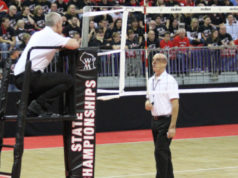Work Together to Correctly Call Faults
It should be easy, but there are many factors that play into our accuracy of whistling net faults. As a second referee (R2), the biggest factor that will improve your ability to whistle these violations is to focus on player action and not follow the ball. While as a first referee (R1), it is imperative you do not leave the net too early after an attack hit or block. This article will focus on “when a net is a net” in our three different rule codes — NFHS, NCAA and USAV — and how we can improve in whistling these violations.
NFHS
In high school volleyball, where NFHS rules are used, it’s quite simple to get this call correct. If a player touches the net, antenna or net cables, it is always a fault (9-6-7). In high school contests, it does not matter whether or not a player is in the action of playing the ball.
When you see contact with the net, antenna or net cables, it is the responsibility of the referees to make this call. The only exceptions are when loose hair touches the net, antenna or net cables, or when the force of a ball hit by the opponent pushes the net or net cable into a player. Here is a common play to examine:
An attack hit near the top of the net pushes the net (top of the tape) into the blocker’s hands (and there was possibly a touch, too).
Possible outcomes: (1) Touch by the blocker and no net fault, play continues; (2) no touch and no net fault, four hits; (3) no touch and no net fault, ball contacts the floor; (4) touch by the blocker and net fault; or (5) net fault only.
In your decision-making process, there should not be an automatic call, nor should it be based on suspicion. In this case, the R2 should focus at the net where the ball is being played, focus on player action and ask, “Did the blocker(s) jump straight up or were they pressing over/toward the net? Did the player touch the net or did the ball cause the net to touch the player?” Additionally (but unrelated to this article), “Was there a touch by the blocker, what happened to the ball next, was there a centerline violation and how can I help my partner?”
It is such a routine play, but there are many possibilities based on what occurs. Just remember, when you choose to whistle a violation you must be 100 percent certain the violation occurred. When in doubt, it is always best to keep the ball flying.
So how can we improve in this area? The communication and pre-match discussion between the referees are of the utmost importance. Although the net is the primary responsibility of second referees, they may occasionally be out of position, not focused in the correct area, or may be doing all the right things but get screened from the play.
In these instances, it would be appropriate for the first referee to make the call, especially for net faults by the attacking team and plays occurring near the first referee (such as a backslide). If this is a topic of discussion, it could help avoid unnecessary multiple whistles, it will prevent referees from feeling like their partner is stepping on their toes and participants will feel like the officiating team is getting the call right.
USAV
The rules for net play are more lenient in USAV and they allow for play to continue more often. Players can only be whistled for a net violation if they make contact with the net, between the antennas, while they are in the action of playing the ball (11.3). This includes their takeoff, hit, attempt to hit or while landing.
What I particularly like about the rule is a player can contact the net outside the antenna, the ropes, the standard or the referee stand and not be whistled for a fault. However, it is possible that a player’s contact with objects outside the antenna could cause interference. If this is true (and obvious), a whistle would be appropriate.
Again, I would recommend a thorough pre-match discussion to discuss who will whistle net violations, situations where your partner may have a better view and when he or she will whistle them, and how you will communicate when play at the net is legal (or judged to be legal) and play should continue. Let’s look at one example and how the referees could handle it.
Play 1: A high-flying attacker has a monster kill but contacts the net while landing. The ball contacts the floor prior to the player contacting the net. Ruling 1: The rally is over and contact with the net would not be a fault.
R2s can use an informal “index finger point” to the floor to let the R1 know they saw the net fault, but the ball was down first or the player had landed (completed the attack), thus no violation.
Or, let’s consider an alternate ending to the same situation and how the referees would handle it.
Play 2: A high-flying attacker has a monster kill but contacts the net while landing. The R2 whistles and begins to signal a net fault on the attacker. The R1 disagrees with the call and judges the ball hit the floor first. Ruling 2: The R1 should draw attention to him or herself with a double whistle, gently tap the chest and signal the ball was down.
This is a case where signaling the violation first and then awarding the point is acceptable. The R2 should be prepared to explain to the coach the R1 judged the ball to have contacted the floor before the net fault and the point will be awarded to the opponent. Be confident in your delivery.
NCAA
The collegiate rule for net violations is similar to the USAV rule and does not stop play for contact with the net or antenna if a player is not in the action of playing the ball (15.2.1).
As is the case with almost all rules, though, there are some minor differences. The NCAA has included interference as rationale to whistle a fault, which means a player not in the action of playing the ball could be whistled for a net fault.
An example of interference would be a blocker who begins to move out to the antenna to participate in a block. As the blocker starts moving, he or she gets wrapped up in the net and it affects the integrity of the net. This draws all players’ attention and interferes with play — whistle it.
The NCAA also defines the action of playing the ball as being completed when the player transitions to his or her next action. The most common example of this is when a player attacks the ball, lands on the floor, then contacts the net while turning to get into a defensive position. This contact with the net is legal because the player’s action was completed and the net was contacted as he or she transitioned back off the net.
Let’s examine a different situation that may make us think a little harder as to whether or not we whistle a net fault: An attacker completes an attack hit, but his or her momentum continues and he or she makes slight contact with the bottom of the net. The R2 is unsure whether or not to whistle a violation.
Things that may cross your mind: Was the player still in original action or had the player transitioned to a new action? How much contact was there? Were you the only one who saw it? Was it inside or outside of the antenna? Did the ball hit the opponent’s court? Will your partner whistle or not? Can I get out of this by whistling and signaling a centerline fault? Are the coaches yelling? Do we have CRS?
The point of that situation is net faults are not always so clear. When coaches, players or fans yell at us, they are seeing, thinking about and wanting a different outcome. Our judgment factors into our decision-making and becomes more important when we officiate USAV and NCAA volleyball.
What are the takeaways? Know the rules and know how to communicate. We must know which rule set is being used for each match, we must have good communication with our partner and we should use rulebook verbiage to explain to players or coaches why we did or did not make a call.
How can you improve in this area? Proper positioning and focus will help you see net faults better. Both referees have the responsibility of being positioned in the right spot and focused in the right area to increase their chances of getting the call right. Be aware and use the “art of officiating.”
It helps when referees know where the players are, what they are doing and where they are going. Also, knowing where the ball is helps us make decisions. We cannot be overfocused on one thing or we lose sight of the bigger picture.
Knowing the rules and when to apply them (or not) is a skill that top-level referees acquire with much practice.
What's Your Call? Leave a Comment:
Note: This article is archival in nature. Rules, interpretations, mechanics, philosophies and other information may or may not be correct for the current year.
This article is the copyright of ©Referee Enterprises, Inc., and may not be republished in whole or in part online, in print or in any capacity without expressed written permission from Referee. The article is made available for educational use by individuals.



















